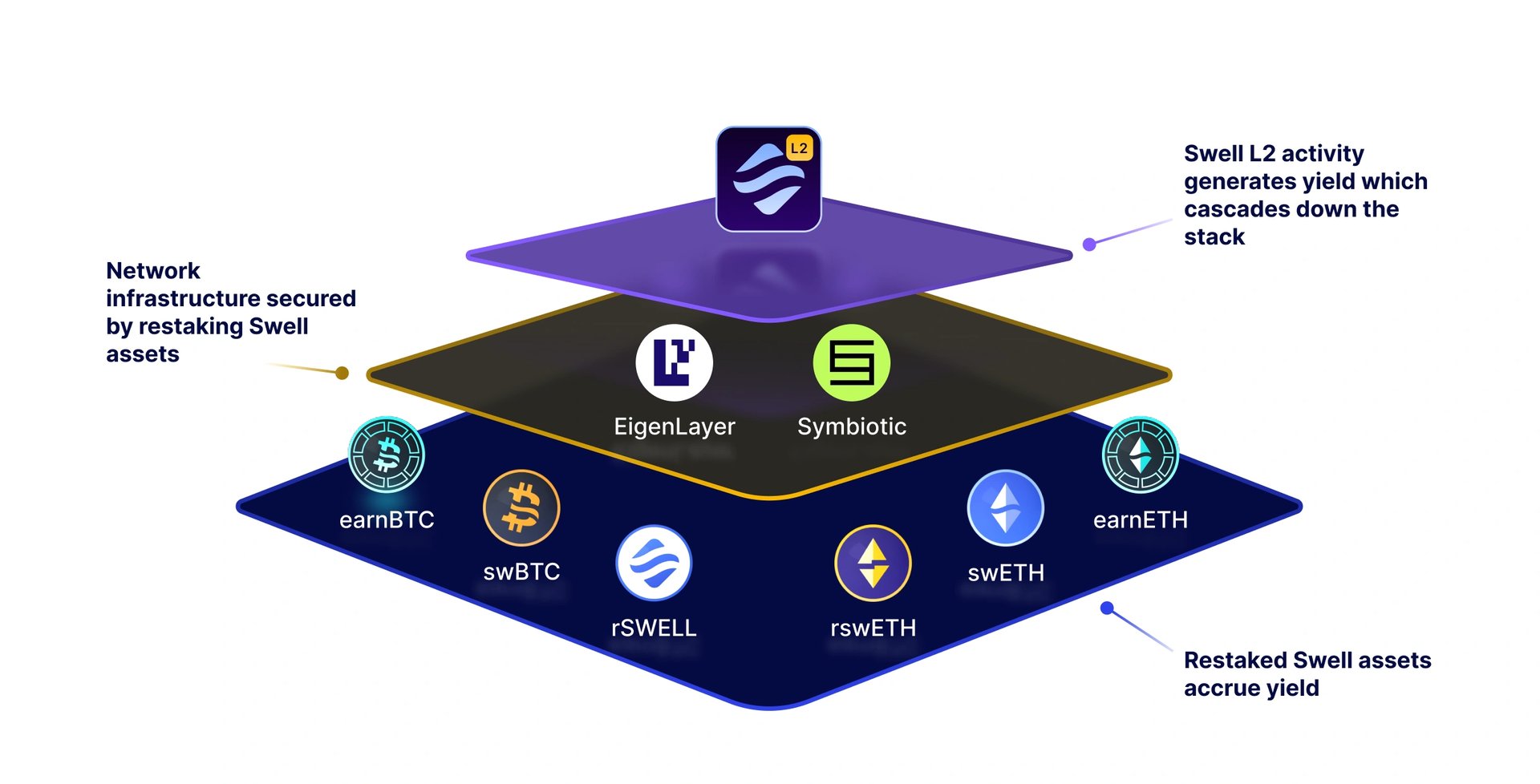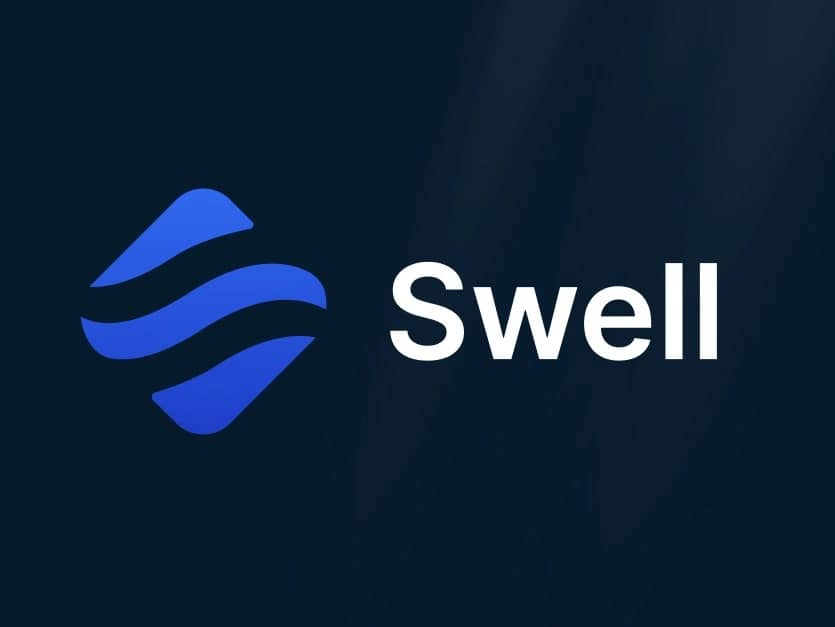Swell Network
**스웰 네트워크(The Swell Network)**는 분산형이자 비보관형 이더리움(ETH) 스테이킹 프로토콜로, 탈중앙화 금융(DeFi) 환경 내에서 수익률을 높이도록 설계되었습니다. 사용자는 스웰을 통해 ETH를 스테이킹하여 수익률을 제공하는 유동 토큰(LST 또는 LRT)을 받는 대가로 블록체인 및 재스테이킹된 AVS 보상을 얻어 수동적 수입을 얻을 수 있습니다. 이러한 유동 토큰은 DeFi 생태계에서 사용 가능합니다. 다니엘 디존(Daniel Dizon)은 스웰의 CEO이자 설립자입니다. [1]
개요
탈중앙화 이더리움(ETH) 스테이킹 프로토콜인 스웰 네트워크(Swell Network)는 탈중앙화 금융(DeFi) 부문의 수익률을 높이고 사용자가 스테이킹된 ETH에 접근할 수 있는 유연성을 제공하는 것을 목표로 합니다. 커뮤니티 중심의 거버넌스 모델을 통해 스웰은 사용자가 중요한 결정에 대한 투표를 통해 프로토콜의 미래를 형성할 수 있도록 지원합니다. 안전성을 우선시하여 지속적인 감사를 실시하고 버그 바운티를 제공하여 강력한 개발을 보장합니다. [1][2]
스웰은 스테이킹 프로세스를 간소화하여 사용자가 ETH를 스테이킹하고 이자를 생성하는 토큰인 swETH를 받는 동시에 다른 DeFi 기회를 위한 유동성을 유지할 수 있도록 합니다. 사용자 친화적인 인터페이스를 통해 플랫폼에서 스테이킹에 쉽게 참여할 수 있습니다. 사용자는 플랫폼을 통해 직접 ETH를 스테이킹하고 즉시 보상을 받기 시작하며, 향후 수익률이 최적화된 볼트에 swETH를 예치하여 수익을 극대화할 수 있습니다. 또한, 스웰 DAO는 커뮤니티 참여를 촉진하여 사용자가 협력적인 의사결정을 통해 생태계 개발 및 거버넌스에 기여할 수 있도록 합니다. [1][2]
Swell DAO
Swell DAO는 유동적 스테이킹 프로토콜을 개발하여 이더리움(ETH) 보유자가 자본을 묶지 않고 스테이킹으로 수익을 얻을 수 있도록 설립되었습니다. Swell은 차별이나 검열 없이 경제적 자유를 증진하는 보다 안전하고, 분산되고, 투명한 금융 미래를 조성하는 것을 목표로 합니다. Swell은 탈중앙화 금융(DeFi)의 중요한 구성 요소로서 유동적 스테이킹을 발전시키는 데 중점을 두고 있으며, 이더리움 생태계와 완전히 통합되고 합성 가능성에 적응할 수 있도록 합니다. [1]
스웰 보야지 (Swell Voyage)
2023년 5월, 스웰 랩스(Swell Labs)는 스웰의 시작부터 성숙 단계까지의 발전 과정을 보여주는 스웰 보야지(Swell Voyage) 캠페인을 시작했습니다. 이 캠페인은 선라이트 존(Sunlight Zone), 트와일라잇 존(Twilight Zone), 미드나잇 존(Midnight Zone), 스웰 시티(Swell City)의 네 개의 장으로 구성되며, 이 기간 동안 거버넌스 권한이 점진적으로 분산되어 초기 커뮤니티 참여자들에게 확대됩니다. 사용자는 캠페인 기간 동안 $SWELL 에어드롭의 일부에 해당하는 진주를 모을 수 있습니다. 이 진주는 보야지의 마지막 장에 도달하면 거버넌스 토큰을 부여합니다. 각 보야지 장에는 서로 다른 목표가 있지만, 참가자는 여정 내내 스테이킹을 계속하고 유동성을 제공하여 진주 수집을 극대화할 수 있습니다. 여정이 진행됨에 따라 개인은 스웰 아쿠아넛(Swell Aquanauts), 스웰의 디스코드 커뮤니티, 디파이(DeFi), 그리고 더 넓은 이더리움 생태계에 도움이 되는 유동적 스테이킹 토큰 개발에 기여할 수 있습니다. [3][4]
Swell L2
Swell L2는 Polygon CDK 기반의 ZK-validium으로, restaking에 중점을 두고 있습니다. EigenLayer 및 Symbiotic과 같은 restaking 프로토콜의 성공에 힘입어, Swell은 EigenLayer에서 swETH의 높은 채택률에 따라 자체 restaked liquid representative token(LRT)인 rswETH를 출시했습니다. Swell은 자사 LRT의 보안을 활용하여 전문 제공업체가 각 구성 요소를 관리하는 모듈 방식의 L2를 분산하고 확장할 수 있다는 것을 깨달았습니다. 이 L2는 SWELL, swBTC, rswETH 세 가지 토큰으로 보안되며, Swell의 liquid staking 및 restaking 제품의 가치를 높이는 동시에 차세대 Layer 2 DeFi를 지원합니다. [15]

리스테이크 증명
리스테이크 증명(PoR)은 스웰의 L2 생태계 내외에서 스테이킹된 자산의 유용성을 높이도록 설계되었습니다. 유동적인 리스테이크 토큰(LRT)을 사용하여 롤업과 체인을 지원하는 인프라를 확보하는 PoR은 자본 효율성을 높이고 스테이커가 생태계에 참여하면서 네트워크 보안에 기여할 수 있도록 합니다. PoR은 검증자, 노드 운영자, 개발자 및 사용자 간의 인센티브를 일치시켜 유동성을 심화시키고 보안을 강화합니다. [16]
스테이커는 LRT로 토큰화된 자산을 예치하여 스테이킹 보상을 생성하고 인프라 서비스, DeFi 및 크로스체인 프로토콜에서 사용할 수 있도록 유동적으로 유지합니다. 온체인 활동은 수익을 창출하고 검증자, 릴레이어, 노드 운영자 및 시퀀서를 지원하는 동시에 스웰 자산에 수익을 축적합니다. 네트워크 활동이 증가함에 따라 유동성이 심화되고 암호화폐 경제적 보안이 강화되어 dApp에 이익이 되고 더 많은 개발자와 사용자를 유치합니다. [16]
PoR의 모듈식 아키텍처를 통해 스웰 L2 인프라가 발전하여 더욱 분산되고 효율적으로 만들 수 있습니다. 리스테이크된 자산으로 주요 구성 요소를 확보함으로써 네트워크는 이더리움의 보안과 일치하며 중앙 집중식 인프라와 관련된 문제를 방지합니다. PoR은 또한 네트워크에서 생성된 수익을 사용자에게 리스테이킹 수익으로 전달하여 자산 생산성을 극대화하고 혁신을 촉진하며 스웰 L2의 분산 서비스와 이더리움의 보안을 활용하는 dApp에 대한 유동성을 해제합니다. [16]
스웰 토큰 (Swell Tokens)
swETH 토큰
스웰 이더(swETH)는 스웰 프로토콜의 유동적 스테이킹 토큰(LST)으로, 이더리움 네트워크에 스테이킹된 ETH를 나타냅니다. 체인링크 준비금 증명은 기반 ETH를 검증합니다. swETH는 재가격화 토큰으로 기능하며, 스테이킹 보상이 누적됨에 따라 시간이 지남에 따라 가치가 증가합니다. [5]
rswETH
2024년 1월 29일에 출시된 rswETH(Restaked Swell ETH)는 ERC-20 기반의 유동적 리스테이킹 토큰(LRT)으로, EigenLayer와 같은 리스테이킹 프로토콜에 ETH를 "리스테이킹"하려는 사용자에게 유동성을 제공하도록 설계되었습니다. 리스테이킹된 ETH를 잠글 필요 없이 사용할 수 있습니다. 검증자가 이더리움 블록체인에서 트랜잭션을 검증하는 데 사용되는 수익률이 있는 사용자의 ETH를 나타내는 재가격 토큰으로 기능합니다. [1][6][7]
2024년 4월 17일에 발표된 rswETH v2는 지원되는 유동적 스테이킹 토큰(LST)과 rswETH 간의 상호 운용성을 도입합니다. 이 업데이트를 통해 swETH 및 stETH와 같은 다른 LST를 주조를 위한 담보로 사용할 수 있습니다. 이를 통해 swETH 보유자는 2차 시장에 의존하지 않고 효율적으로 rswETH를 얻을 수 있습니다. [12]
rswETH v2는 rswETH를 통해 리스테이킹된 ETH 및 LST를 EigenLayer AVS 운영자에게 자동으로 위임합니다. 이는 신뢰할 수 있는 운영자가 자산을 관리하고, 리스테이커는 실제 리스테이킹 수익률(활성화되면), 잠재적인 AVS 에어드롭 및 Swell L2에 rswETH를 예치하여 얻는 추가 보상을 포함하여 에코시스템 전반의 보상을 얻을 수 있도록 합니다. 사용자는 Swell 앱을 통해 주요 시장 가격으로 rswETH를 인출할 수 있으므로 2차 시장에 대한 의존도가 줄어들고 안정성이 향상됩니다. 이 기능이 활성화될 때까지 rswETH는 DEX 또는 집계기를 통해 ETH로 다시 교환할 수 있습니다. rswETH를 뒷받침하는 스테이킹된 자산은 Chainlink 예비금 증명을 사용하여 검증할 수 있습니다. [12]
향상된 rswETH는 Swell L2에서 삼중 스테이킹의 중요한 구성 요소가 되어 SWELL, ALT, 및 rswETH가 AltLayer의 AltVault를 통해 Swell L2 AVS를 보호할 수 있도록 합니다. rswETH는 또한 Swell L2의 기본 가스 토큰 역할을 하여 유틸리티를 높이고 스테이킹 및 리스테이킹 보상을 통해 보유량이 증가함에 따라 사용자 경험과 가스 비용을 최적화합니다. [12]

SWELL 토큰
SWELL은 Swell의 네이티브 토큰으로, 세 가지 주요 목적을 가지고 있습니다. Swell DAO에 대한 거버넌스, Swell L2 애플리케이션 및 인프라 보안을 위한 리스테이킹, 그리고 네트워크 가스 비용 지불입니다. 사용자는 SWELL을 리스테이킹하여 rSWELL을 받고, Swell L2 보안에 대한 보상을 얻을 수 있습니다. 유동적인 리스테이킹 토큰인 rSWELL은 SWELL과 1:1 거버넌스 권한을 유지하며, 추가 수익을 위한 DeFi에 사용하거나 Swell L2에 예치하여 에코시스템 에어드롭을 받을 수 있습니다. 거버넌스를 통해 SWELL 및 rSWELL 보유자는 Swell DAO에서 제안을 제출하고 투표할 수 있으며, 유동성 인센티브, 프로토콜 매개변수, 보조금 배포, 그리고 노드 운영자 온보딩 등에 대한 결정을 내립니다. SWELL은 Swell L2 트랜잭션의 가스 토큰으로도 사용됩니다. SWELL의 총 공급량은 100억 토큰이며, 8.5%는 Voyage 에어드롭에 할당되었습니다. [1][14]

파트너십
Bunni
2023년 5월, Swell은 DeFi의 유동성 인센티브 문제를 해결하는 프로젝트인 Bunni에서 swETH-ETH 풀을 출시했습니다. Swell이 LST 공간에 새롭게 진출했기 때문에 거버넌스 토큰 없이 유동성을 확보할 기회가 있었습니다. 거버넌스 토큰 없이 Bunni와의 협력 결정은 상대적으로 낮은 veLIT의 가치 평가와 새로운 프로토콜이라는 Bunni의 지위와 같은 요인에 의해 영향을 받았습니다. 이 전략적 파트너십을 통해 배출된 것이 다시 돌아오도록 함으로써 거버넌스 토큰 없이도 더욱 두드러진 위치를 유지하고 유동성을 향상시킬 수 있었습니다. [8]
Chainlink
2023년 5월 16일, Swell은 이더리움(Ethereum)에서 Chainlink Proof of Reserve (PoR) (체인링크 증명 준비금(PoR))을 통합하여 swETH 토큰이 staked (스테이킹)된 ETH (이더리움(Ethereum))에 1:1 비율로 완전히 뒷받침됨을 보장했습니다. Chainlink PoR (체인링크 PoR) 통합은 swETH를 뒷받침하는 ETH (이더리움(Ethereum)) 준비금에 대한 모니터링 서비스를 제공하여 사용자에게 신뢰할 수 있고 시기 적절한 업데이트를 제공했습니다. 이러한 계획은 Ethereum’s (이더리움(Ethereum)) Beacon chain 준비금의 완전한 뒷받침에 대한 사용자의 신뢰와 투명성을 높이기 위한 것이었습니다. 사용자는 Proof of Reserve (증명 준비금) 피드에 접근하여 확인할 수 있었습니다. [9]
“Chainlink Proof of Reserve (체인링크 증명 준비금)는 swETH를 뒷받침하는 준비금에 대한 최고 수준의 투명성을 사용자에게 제공하는 데 도움이 됩니다. 사용자는 이제 swETH 준비금 잔액에 대한 거의 실시간 업데이트를 확인할 수 있는 원스톱 목적지를 갖게 되어 모든 토큰이 스테이킹된 ETH (이더리움(Ethereum))에 1:1로 뒷받침된다는 안심을 제공합니다.” -Daniel Dizon, Swell Network 공동 설립자 겸 CEO.
2024년 2월, Swell은 보안 및 신뢰성 향상을 목표로 Chainlink’s (체인링크(Chainlink)) BUILD 프로그램에 참여하여 Chainlink’s (체인링크(Chainlink)) oracle (오라클) 인프라를 활용했습니다. BUILD 회원으로서 Swell Network는 안전한 크로스체인 전송을 위한 Chainlink’s (체인링크(Chainlink)) Cross-Chain Interoperability Protocol (CCIP, 크로스체인 상호운용성 프로토콜), 크로스체인 준비금 검증을 위한 Chainlink Proof of Reserve (체인링크 증명 준비금), smart contract (스마트 계약) 트리거를 위한 자동화, 정확한 시장 데이터를 위한 Price Feeds (가격 피드), 오프체인 데이터 및 사용자 지정 계산을 위한 Functions (함수), 그리고 새로운 Chainlink 제품 출시에 대한 조기 접근 등 다양한 혜택을 누릴 수 있었습니다. 이러한 서비스에 대한 대가로 Swell Network는 자체 토큰 공급의 일부를 스테이커를 포함한 Chainlink (체인링크(Chainlink)) 서비스 제공업체에 점진적으로 제공하기로 약속했습니다. 이러한 상호 협력은 양측 커뮤니티 간의 상호 지원을 가능하게 했습니다. [10]
“Chainlink (체인링크(Chainlink)) BUILD 프로그램에 참여하게 되어 기쁩니다. Chainlink (체인링크(Chainlink)) Network의 업계 표준 서비스는 Swell이 DeFi (디파이)에서 liquid staking (유동적 스테이킹) 채택을 지원하는 데 필수적입니다. 앞으로도 지속적인 협력을 기대하며 열정적인 Chainlink (체인링크(Chainlink)) 커뮤니티를 Swell Network 생태계에 환영합니다.” -Daniel Dizon, Swell Network 공동 설립자 겸 CEO.
AltLayer
2024년 3월 13일, Swell은 AltLayer(알트레이어) 및 EigenDA와 파트너십을 맺고 restaking을 위한 Layer 2(레이어 2) rollup(롤업)을 출시했습니다. Swell의 L2(레이어 2)는 EigenLayer(아이겐레이어)에서 liquid restaked 자산에 초점을 맞추며, AltLayer(알트레이어)의 "restaked rollup(리스테이크드 롤업)" 프레임워크를 활용하여 기존 rollups(롤업)과 차별화됩니다. 이 프레임워크에는 분산 시퀀싱, 검증 및 EigenLayer’s(아이겐레이어) restaking 메커니즘을 통한 더 빠른 최종성과 같은 Actively Validated Services(AVS)가 포함됩니다. [11]
이 rollup(롤업)은 Swell 생태계 참여자에게 네이티브 restaking 수익률, 향상된 확장성, 낮은 수수료 및 새로운 DeFi(디파이) 기본 요소를 제공합니다. 네이티브 gas(가스) 토큰은 rswETH이며, 거버넌스 토큰은 SWELL입니다. Chainlink(체인링크)는 EigenDA의 Polygon’s(폴리곤) zkEVM(이브엠) 기술 기반으로 구축된 L2(레이어 2)를 지원합니다. AltLayer(알트레이어)도 함께 합니다. [11]
“Swell의 liquid restaking 상품을 restaking을 위한 L2(레이어 2)로 확장하는 것은 Swell 커뮤니티와 DAO(다오)의 다음 논리적 단계입니다. 이는 DeFi(디파이)에 최고의 liquid restaking 경험을 제공하려는 프로토콜의 기존 비전을 확장합니다. Swell의 L2(레이어 2)는 Swell 커뮤니티에 획기적인 변화를 가져오고, EigenLayer(아이겐레이어) 및 그 성장하는 Actively Validated Services(AVS) 생태계와 함께 DeFi(디파이)에 새로운 혁신을 제공할 것입니다.” - Daniel Dizon(다니엘 디존), Swell Network 공동 설립자 겸 CEO.
OKX
2024년 3월 29일, Swell은 최근 출시한 Layer 2 및 OKX의 자체 Layer 2 네트워크에서의 재스테이킹 성장을 지원하기 위해 OKX와의 협력을 강화한다고 발표했습니다. 이 파트너십은 Polygon의 CDK 기반으로 구축된 Swell의 재스테이킹된 rollup과 OKX의 Layer 2 간의 시너지 효과를 창출하는 것을 목표로 했습니다. 이러한 네트워크는 Polygon AggLayer를 통해 더 광범위한 ZK 기반 Layer 2s 네트워크 내에서 상호 운용되도록 설계되었습니다. [13]
